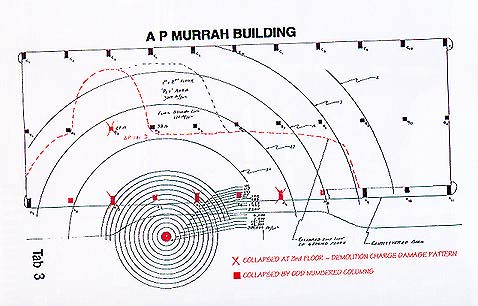Bomb Damage Analysis of the Alfred P. Murrah Federal Building Oklahoma City, Oklahoma
From a report by Benton K. Partin, Brigadier Gen. USAF (Ret.) Ken's quick explanation of Partin's diagram: 1. The red dot surrounded by circles shows the location of the truck bomb. 2. The force of an explosion (pounds per square inch) diminishes drastically as it moves through air. By the time it reaches column B-3, in the second tier of columns, it is only 27 pounds per square inch. 3. Column B-3 was entirely taken out while the column next to it B-4 which would have received slightly more force was untouched. 4. Columns A-3, A-5, and A-7 were collapsed at the 3rd floor level. Columns A-4, A-6, and A-8 were collapsed by the odd number columns adjacent to them. Note that Column A-7 is well out of the area of main blast force. 5. These results are entirely consistent with demolition charges going off on B-3, A-3, A-5, and A-7. The size of the explosives needed would be minimal if there were attached directly to the columns. 6. Several experienced demoltion experts, physicists and munitions experts agree with Partin that there is no way this damage could have been done by the truck bomb alone. None of these were permitted to be witnesses on the McVeigh or Nichols trial. The only munitions expert allowed to testify was from the UK and her testimony did not address Partin's thesis. 7. Contrary to investigative procedures - and common sense - the Murrah Building was demolished and its remains were buried in a local landfill. Requests for an independent examination of the evidence were denied.
|
